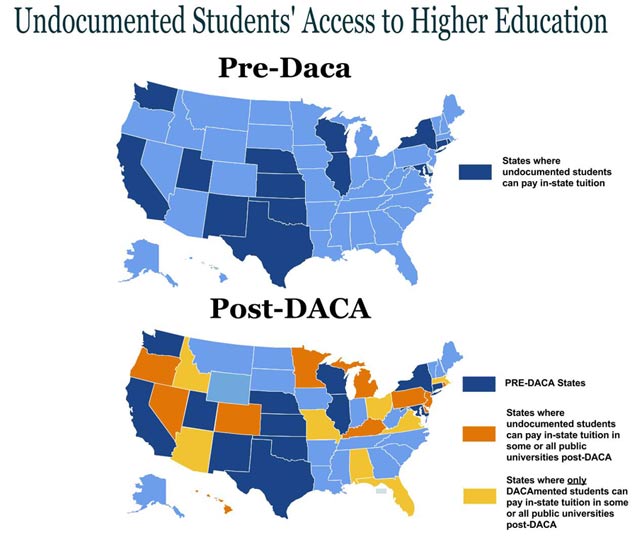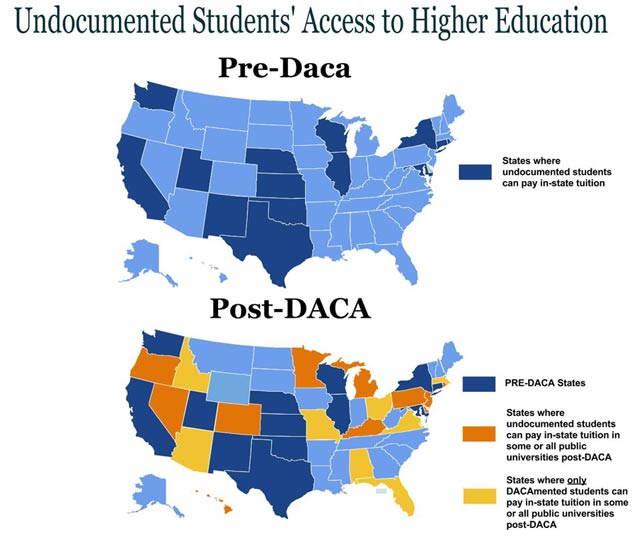
Miguel Tapia was 13 when he found out what it means to be an undocumented American.
His parents explained that even though he had lived in Delaware since he was 2, he could not get a drivers license, apply for federal financial aid, or work legally in the United States.
Tapia found the news difficult to handle. The Mexican-born youth considered himself American, spoke accentless English, and saw his Delaware community as home.
He had worked diligently throughout middle school, maintaining a 4.0 GPA, because he wanted to prepare for college and a career in education policy. “Mom,” the teen recalls asking his mother, feeling defeated, “Why am I working so hard? Why am I a 4.0 student? Why am I at the top of my class? In the end I’ll be working as an undocumented immigrant, at a job that pays minimum wage.”
Tapia’s pessimism dissolved on June 15, 2012 when President Obama launched the Deferred Action for Childhood Arrivals (DACA) program. This temporary initiative gives immigration authorities the power to grant young, undocumented immigrants like Tapia the right to legally work and live in the United States for renewable two-year periods.
When Obama passed the executive action, Tapia, who is currently a straight-A high school senior and a member of a United Way committee that aims to improve minority students’ access to a quality education in Delaware, was ecstatic. Obama’s executive order promised to help newly “DACAmented” youth like Tapia open doors that had previously been closed to them.
“Something as simple as getting a drivers license became possible, and I could start thinking more long-term about my career goals. Obama’s decision also gave me a sense of self-worth. It empowered me. It erased a sense of disillusion I carried deep within regarding my future,” the 17-year-old Tapia revealed.
Over the past two years, thousands of other young people have found themselves in Tapia’s shoes. As of March 2014, nearly 650,000 young adults had applied for deferred action, and over 550,000 had been approved.
This temporary permit has eradicated roadblocks that previously kept undocumented youth from integrating into mainstream America.
Prior to DACA, only 14 states allowed undocumented students to pay in-state tuition in public universities. After President Obama signed the executive order, at least 16 more states extended in-state rates to local undocumented or DACAmented students.

In blue states like Massachusetts, this means that DACAmented students can pay $13,230 instead of $26,645 a year to attend the University of Massachusetts at Amherst.
In more conservative states like Alabama, the effect has been even more profound. Alabama passed H.B. 56 in 2011, which banned all undocumented students from public universities and colleges. For Beatriz, a young woman who moved to Alabama from Mexico City when she was 2 and speaks English with a Southern drawl, the law was demoralizing.
When the law passed, Beatriz was a rising high school senior with a near-perfect GPA and plans to attend a public college in Alabama. She also volunteered as a tutor in her community and was an active member of the student council. Despite her academic record, Beatriz, who did not live legally in the United States, could not attend a state college.
DACA changed everything. Because students with deferred action no longer fell under the “undocumented” category, public colleges in Alabama began enrolling them as Alabama residents. When Beatriz heard that she could attend college and pay in-state tuition in Alabama, she felt a sense of relief. “All of my hard work was going to pay off,” she said in our hour-long interview.
Beatriz is now a second-year student at a community college in Alabama and plans to continue her studies until she finishes law school. Ultimately, she wants to work in her Alabama community as an attorney or public official to safeguard children’s right to a quality education.
Such policy changes in state education systems have made a college education more accessible for nearly 90 percent of the DACAmented population. But the benefits go far beyond greater access to public colleges.
Harvard University professor Roberto G. Gonzales recently released a report assessing how DACA has normalized life for previously undocumented people. His findings show that 59 percent of DACA-eligible youth have gotten a new job, and nearly half have increased their earnings. Some 57 percent have received new drivers licenses. Half have opened their first bank account, a third have applied for their first credit card, and nearly a quarter have obtained healthcare.
DACAmented youth, however, argue that the temporary program is not enough. The program is only for youth who were under 31 on June 15, 2012 and who are currently in high school or who have attained a high school diploma or GED. Even eligible young adults are forced to reapply every two years, and if their status lapses before their application for renewal is approved, the consequences—which could include the loss of work privileges or even deportation—could be devastating. More worrying still, a future president could revoke their protections with the stroke of a pen.
There are no protections at all for young people who didn’t graduate high school or who fall outside DACA’s age range. Additionally, more than 70 percent of youth with deferred action status have undocumented family members who could potentially earn their U.S. residency through comprehensive immigration reform.
As Tapia explains, “We still need to do much more. We are only a small percentage of the 11.7 million or so undocumented immigrants who are here. What about my parents, what about my uncles, what about my aunts, what about other people? And what about me, if DACA is discontinued?”
Help us Prepare for Trump’s Day One
Trump is busy getting ready for Day One of his presidency – but so is Truthout.
Trump has made it no secret that he is planning a demolition-style attack on both specific communities and democracy as a whole, beginning on his first day in office. With over 25 executive orders and directives queued up for January 20, he’s promised to “launch the largest deportation program in American history,” roll back anti-discrimination protections for transgender students, and implement a “drill, drill, drill” approach to ramp up oil and gas extraction.
Organizations like Truthout are also being threatened by legislation like HR 9495, the “nonprofit killer bill” that would allow the Treasury Secretary to declare any nonprofit a “terrorist-supporting organization” and strip its tax-exempt status without due process. Progressive media like Truthout that has courageously focused on reporting on Israel’s genocide in Gaza are in the bill’s crosshairs.
As journalists, we have a responsibility to look at hard realities and communicate them to you. We hope that you, like us, can use this information to prepare for what’s to come.
And if you feel uncertain about what to do in the face of a second Trump administration, we invite you to be an indispensable part of Truthout’s preparations.
In addition to covering the widespread onslaught of draconian policy, we’re shoring up our resources for what might come next for progressive media: bad-faith lawsuits from far-right ghouls, legislation that seeks to strip us of our ability to receive tax-deductible donations, and further throttling of our reach on social media platforms owned by Trump’s sycophants.
We’re preparing right now for Trump’s Day One: building a brave coalition of movement media; reaching out to the activists, academics, and thinkers we trust to shine a light on the inner workings of authoritarianism; and planning to use journalism as a tool to equip movements to protect the people, lands, and principles most vulnerable to Trump’s destruction.
We urgently need your help to prepare. As you know, our December fundraiser is our most important of the year and will determine the scale of work we’ll be able to do in 2025. We’ve set two goals: to raise $81,000 in one-time donations and to add 1250 new monthly donors by midnight on December 31.
Today, we’re asking all of our readers to start a monthly donation or make a one-time donation – as a commitment to stand with us on day one of Trump’s presidency, and every day after that, as we produce journalism that combats authoritarianism, censorship, injustice, and misinformation. You’re an essential part of our future – please join the movement by making a tax-deductible donation today.
If you have the means to make a substantial gift, please dig deep during this critical time!
With gratitude and resolve,
Maya, Negin, Saima, and Ziggy